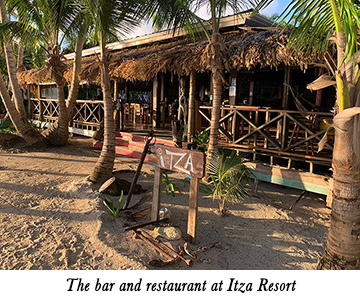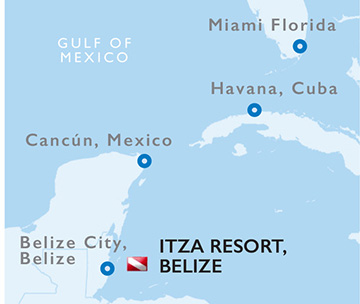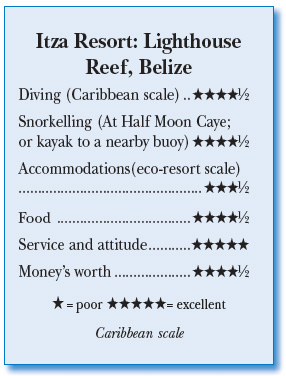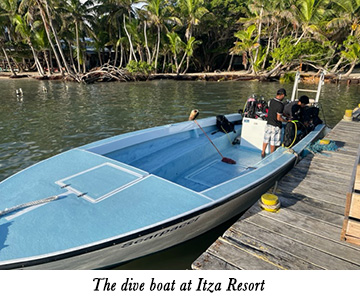Itza Resort: Lighthouse Reef, BelizeContents of this Issue: Itza Resort: Lighthouse Reef, Belize Tough Punishment for an Unauthorized Dive Boat Buoy Line El Galleon Resort, The Philippines That Deadly Underwater Debris: Scuba Scene – Another Liveaboard Burns Were You Booked on a Future Scuba Scene Trip? Overtaken by the Race for Certification or Age? Caribbean Reefs Take a Further Battering Have Dive Accidents and Fatalities Increased? Editorial Office: Ben Davison Publisher and Editor Undercurrent 3020 Bridgeway, Suite 102 Sausalito, CA 94965 fine diving at the end of the Maya World from the June, 2022 issue of Undercurrent
Dear Reader: I'm always searching for small, isolated places with healthy reefs, as I found six years ago at Itza Resort on Long Caye, 50 miles off the Belize Coast, at Lighthouse Reef (see April 2016 Undercurrent). So I returned in February, eager to see if it was still a pleasant place with good fishy reefs.
I had made reservations for myself and six other friends several weeks before our trip. As a condition of coming, I wanted the assurance that we would dive together and without others. Elvis Solis, the manager, dive shop owner, guide, and jack of all trades, went one better. Since no one else was scheduled, he said he would take no other guests. We could have the whole place to ourselves. And the first afternoon, when I joined my friends for Elvis' briefing in the comfortable lounge, with sofas, books, and a giant floor map of Lighthouse Reef, he went one further. While our package included 17 dives, we could dive as much as we wanted. I ended up doing sixteen, and only once did our group do four dives. The next day, the wind and rain made me wonder how many dives I would want to make after we were limited to a 30-foot dive to a protected site as the only dive of the day. While I was happy to get back in the water, this was an ordinary dive at best, with mainly juvenile reef fish and nothing more unique than a saddled blenny and a sharptail eel. I had no way to know whether the diving would measure up to six years ago. Fingers crossed. The next dive day, fingers uncrossed. After a 10-minute boat ride to Half Moon Caye, we dived Roller Coaster and then Half Moon Caye Wall, both with a good dose of reef sharks and friendly Nassau grouper. At the wall, I passed chubs and schoolmasters hovering under the boat as I descended to the sand. I kicked along the fishy crest down to 75 feet, spooking a turtle. Reef sharks patrolled in the blue, showing off their muscular builds, some shadowed by bar jacks. Husky tiger and black groupers hide in the cracks. After 35 minutes, Elvis motioned us to the reef top to burn off nitrogen and swim with parrots, chalk bass, goldspot and bridled blennies, and barred hamlets. My partner showed me five Peterson shrimp in a corkscrew anemone, and soon, a southern stingray sailed by, chasing garden eels back into their holes, and leaving just their eyeballs showing. A saucer-eye porgy joined a mixed school of striped and spotted goatfish as it was time to head up. I made five wall dives at Half Moon Caye, and while they were similar, each provided an excellent variety of fish and good coral formations on a wall with some more live coral than most Caribbean reefs. The viz was always good in the 80-degree water. And plenty of inverts on the back reef and in turtle grass. Here are some of the Caribbean's best dives, as well as a unique little nature walk to visit the incredible redfooted booby bird rookery. After the last dive of the day, I always enjoy a hot shower, but at Itza, it's tepid water, and for a good reason. All freshwater is rainwater, directed to cisterns for storage, and prone to running short. When the water heating system broke down a while back, water use dropped by 80 percent. Voila! So, no repair and now year-round water. As far as I know, most of the Belize out-islands live on rainwater, except Ambergris Caye, which has a small desalinization plant, thanks to expensive residential and hotel development. The shower was tolerable, and I came to an eco-lodge knowing what to expect, including no air-conditioning. But the trade winds usually cooled my upstairs room, as well as the open-air bar and lodge-central. Solar panels and a generator provided reliable electricity, and there's decent WIFI in the lodge. The social center is the large open-air restaurant and bar, where guests, staff, and occasional visitors hang out to visit, eat, drink Belikan beer, and swap dive stories. Indeed, it's a comfy, handsome, well-maintained resort. The builder sold it but still owns the remainder of the 3-mile-long island, planning someday to sell vacation home parcels but keeping most of the Caye, a mangrove lagoon, undeveloped.
By 8:30, I had bacon and eggs for breakfast (my partner preferred the tropical fruit and yogurt), and I was on the dive boat for the first dive, then usually back at 10 a.m. for our surface interval. Blue Hole Day is typically Wednesday, but we made the 20-minute trip on Thursday because of a hasty wind. Diving it the north side of the 1000-foot-wide cenote, not the usual Southside stalactite site, I dropped down the sheer wall to 135 feet through a narrow alcove, past the giant stalactites. It's a brief stay, and I headed up, pausing at 90 feet, where divers can enter a small cave and take a short swim-thru to exit another cave. Once back in the shallows, it was a fishy swim back to the boat, and I was wowed by at least 100 stoplight parrots skittering past me. After the dive, we passed up weights and gear, climbed the hefty ladder, and dropped our masks into the water buckets. Elvis, a strong personality, owns the well-stocked dive shop and constructed his 34-foot broad beam all-purpose open boat. It is not an ideal dive boat, though it was spacious for our group size. (If he has more divers, he hires a crew, divemaster, and boats from elsewhere for the week.) Strapped in their BCDs, tanks are racked and stacked at the stern; at dive time, the crew passed them along to divers sitting on the gunwale, preparing to back roll. On the first day, a new crew member passed me my tank with the air shut off as I perched on the gunwale, unable to reach the valve. Another diver in our group had his gear mishandled. When he brought it up to Elvis over breakfast, Elvis mocked him. My friend, not a shrinking violet, ticked off some problems with the new staffer. This seemed to clear the air, so the ego-bumping ended. Overall, Elvis ran a solid operation, always on time, fills consistently 3000 or better; he repaired my regulator, got us a couple of 100 cf tanks for our heavy breathers, and provided special attention to a rusty diver in our group. He liked that we preferred exploring to chasing down barracudas, so he could have fun poking around and showing interesting stuff. "It's a lot more fun to have a group like yours" was a welcome compliment.
One day, we headed for the aptly-named Aquarium site, with a brightly shining sun and excellent visibility. I kicked to the wall in the 80-degree calm water, watching yellowhead jawfish and a green moray. A trumpetfish hovered vertically next to a sea fan, eying the surroundings for prey. I handed Elvis a spare magnifying glass to pinpoint tiny secretary blennies, which he put to good use the rest of the week. A shark with two remoras passed below, and I found a sea fan with five neck crabs. I saw lots of parrots on this dive: princess, stoplight, red band, and striped. Elvis found a beautiful rare flameback angel. Elvis is a creature scout. He unearthed a bizarre 3-inch fish he called a snake blenny in the sand flats. I've found a few inverts not in the Paul Humann books, but never a fish. When I later asked why some reefs had fewer sharks and more algae growth, he claimed it's the lionfish population: where divers hunt lionfish, sharks become acclimated to divers who may feed them: more sharks, fewer lionfish means more surviving algae-eating fish. He is trying to teach grouper to eat lionfish, and I watched him use a probe to nudge a lion out of its lair. A big Nassau quickly devoured it. Elvis raised his arms victoriously. In my downtime, I walked around the island, exploring, birding -- I watched a resident osprey, royal terns lining the dock, green and night herons in the trees and marsh -- and collecting bug bites. None of my friends took out the kayaks and paddleboards. The crew hoses off the gear daily. When I packed my gear to head home, I licked my BC to test for salt. It was a definite reminder to soak my gear back home.
Having the place to ourselves meant not making new friends but rekindling old relations -- we were from four different cities. So, we talked diving and critters, discussed politics, and caught up on gossip over Belikan beers or whatever cocktails we wished to order. For us, it was a welcome and quiet respite. When we were to depart Saturday morning, 20 divers would arrive. Elvis would import a boat and divemaster from other islands to serve them. Heading to a small resort, I've found it takes a little more advance investigation before booking over many years of going to smaller and less-traveled places. Elvis and the admin manager, Wendy Argueta, were easy to reach by phone or email and very helpful if a little tired of my questions. With a full resort, I wonder how well the tiny operation, heavily dependent on one person, could handle that crowd. It might be a very different experience. PS: Wake Forest University sends people to the island each year for research on the continued degradation of coral reefs. The Lighthouse reefs, 50 miles offshore, are among the healthiest of the Caribbean, but sadly, each visit shows a little less live coral cover. -- M.A. Our Undercover Diver's Bio: Along with his partner, the author has been diving and exploring Central America and the Caribbean for over 35 years, mostly on roads less traveled. He's written several reports for Undercurrent. He's witnessed the deterioration of coral reefs over that time and says "only radical political change will save the reefs, the forests, and a future for nature."
|

I want to get all the stories! Tell me how I can become an Undercurrent Online Member and get online access to all the articles of Undercurrent as well as thousands of first hand reports on dive operations world-wide
| Home | Online Members Area | My Account |
Login
|
Join
|
| Travel Index |
Dive Resort & Liveaboard Reviews
|
Featured Reports
|
Recent
Issues
|
Back Issues
|
|
Dive Gear
Index
|
Health/Safety Index
|
Environment & Misc.
Index
|
Seasonal Planner
|
Blogs
|
Free Articles
|
Book Picks
|
News
|
|
Special Offers
|
RSS
|
FAQ
|
About Us
|
Contact Us
|
Links
|
3020 Bridgeway, Ste 102, Sausalito, Ca 94965
All rights reserved.

 At the edge of the world's second-longest barrier reef, Itza picks up guests in Belize City on Wednesdays and Saturdays for the long boat ride out, the comfort of which depends upon the weather. In my case, the seas were calm, and two hours later, the resort staff handed me a drink and led me to the same comfortable second-floor ocean view room I had previously.
At the edge of the world's second-longest barrier reef, Itza picks up guests in Belize City on Wednesdays and Saturdays for the long boat ride out, the comfort of which depends upon the weather. In my case, the seas were calm, and two hours later, the resort staff handed me a drink and led me to the same comfortable second-floor ocean view room I had previously. I usually woke early and went downstairs to pick up coffee for my partner, then checked emails and wrote some notes. Some mornings I visited the fishermen who hung out on the island. Their work is grueling: 10 days or more out on a tiny, crowded boat, but their scruffy appearance didn't mean they were dirt-poor. One explained that he could make US$200 a day free-diving for conch. Another said he spoke three languages -- English, Spanish, and Belizean Creole -- and told me he was learning Low German to better communicate with the mainland Mennonite farmers he deals with. (They migrated to Belize -- then British Honduras -- in the '50s and today operate modern farms and produce most of Belize's agriculture.)
I usually woke early and went downstairs to pick up coffee for my partner, then checked emails and wrote some notes. Some mornings I visited the fishermen who hung out on the island. Their work is grueling: 10 days or more out on a tiny, crowded boat, but their scruffy appearance didn't mean they were dirt-poor. One explained that he could make US$200 a day free-diving for conch. Another said he spoke three languages -- English, Spanish, and Belizean Creole -- and told me he was learning Low German to better communicate with the mainland Mennonite farmers he deals with. (They migrated to Belize -- then British Honduras -- in the '50s and today operate modern farms and produce most of Belize's agriculture.) While the original inhabitants of Belize, the Mayan people, considered Lighthouse Reef the end of their world, it's not too far away to attract a fantastic trained chef, Chef Douglas, who has worked at other Belize resorts. I looked forward to his every meal. One dinner was honey balsamic pork belly or lemon-garlic shrimp pasta with sautéed veggies and chocolate cake with cream cheese frosting. Another was ham bruschetta, cobb salad with grilled barracuda, and tropical brownies and ice cream. Lunches were similarly well prepared. When I told him I liked conch fritters, they came out as happy-hour snacks the next day. Noeli (called Lee), on the kitchen staff and bar, was competent and likable.
While the original inhabitants of Belize, the Mayan people, considered Lighthouse Reef the end of their world, it's not too far away to attract a fantastic trained chef, Chef Douglas, who has worked at other Belize resorts. I looked forward to his every meal. One dinner was honey balsamic pork belly or lemon-garlic shrimp pasta with sautéed veggies and chocolate cake with cream cheese frosting. Another was ham bruschetta, cobb salad with grilled barracuda, and tropical brownies and ice cream. Lunches were similarly well prepared. When I told him I liked conch fritters, they came out as happy-hour snacks the next day. Noeli (called Lee), on the kitchen staff and bar, was competent and likable. My only night dive was at Nightwatch, on the reef close by the dock. Never dropping below 30 feet, I watched the red army of cardinalfish coming out to speckle the water column. Dozens of juvenile squid joined them, and aided by my dive light, two cardinals became squid dinner. Parrotfish, sporting weird colors and floppy postures, retired for the night. Two lobsters marched past. I studied the active corals, their waving polyps extended to feed. Sadly, this highlights the low percentage of live coral cover. After an hour, I climbed back on the boat cold, wet -- there were no towels -- and eager for a shower and dinner.
My only night dive was at Nightwatch, on the reef close by the dock. Never dropping below 30 feet, I watched the red army of cardinalfish coming out to speckle the water column. Dozens of juvenile squid joined them, and aided by my dive light, two cardinals became squid dinner. Parrotfish, sporting weird colors and floppy postures, retired for the night. Two lobsters marched past. I studied the active corals, their waving polyps extended to feed. Sadly, this highlights the low percentage of live coral cover. After an hour, I climbed back on the boat cold, wet -- there were no towels -- and eager for a shower and dinner. Divers Compass: I paid $2178.50 per person (double occupancy), taxes included for a 7-day package. . . a bit below the posted price . . . Bugs fly when the breeze is down, so I wore long pants and swabbed on the DEET . . . . I left a generous pool tip (cash) and used a card to pay the bar bill and park fees (Blue Hole and Half Moon Caye). The WIFI is fine for email. . . calls can be made over the internet. USD accepted everywhere in Belize (US$1 = $2 BZ). Wendy was helpful via email.
Divers Compass: I paid $2178.50 per person (double occupancy), taxes included for a 7-day package. . . a bit below the posted price . . . Bugs fly when the breeze is down, so I wore long pants and swabbed on the DEET . . . . I left a generous pool tip (cash) and used a card to pay the bar bill and park fees (Blue Hole and Half Moon Caye). The WIFI is fine for email. . . calls can be made over the internet. USD accepted everywhere in Belize (US$1 = $2 BZ). Wendy was helpful via email. 